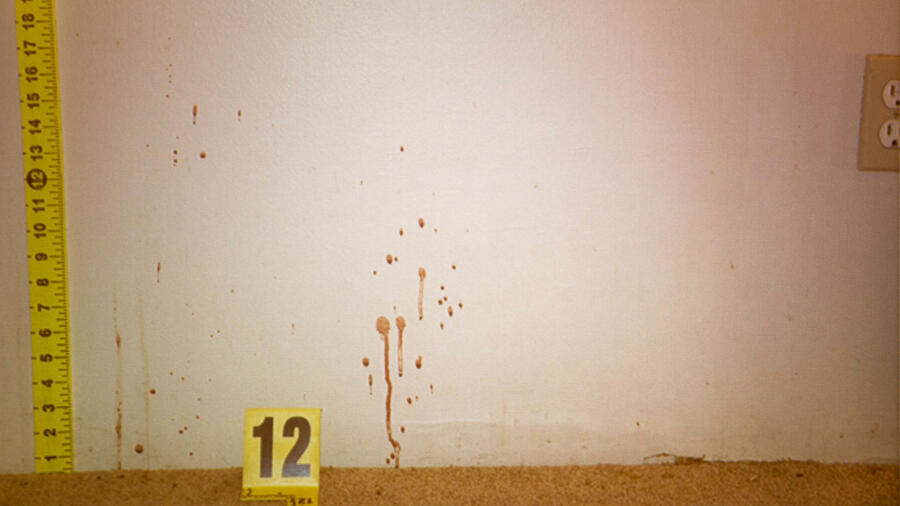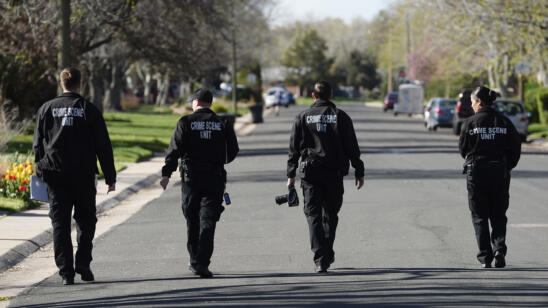When Denver police found Emily Johnson brutalized outside her house in the early morning hours of January 1, 2000, it seemed like an open-and-shut murder case—at first. The 29-year-old teacher had been bludgeoned inside the home, then dragged outside to the backyard where she was smashed in the head with a large rock.
Johnson’s boyfriend, Robert Davis, was the only other person in the home: He was in the bedroom, upstairs, and he claimed to have slept through the whole thing.
The police thought they had a prime suspect. But the blood told them a different story.
“I’m looking around [the scene] and there were a lot of things that didn’t make any sense,” says Jonathyn Priest, a now-retired Denver police detective.
“There was so much blood on the scene, yet the male who was asleep in bed [Davis] had no blood on him, and there was no trail between where the victim had been beaten and the bedroom and no indication that he had cleaned up anywhere,” says Priest. “Yet he was the primary suspect. After looking at this scene I said, ‘I don’t think so.’ ”
Priest had been called in to investigate the murder as he almost always was when blood was spilt in the Mile High City.
During his 32 years with the Denver Police Department, Priest had become the city’s preeminent expert on bloodstain pattern analysis (BPA). He estimates he handled around 80 percent of its blood scenes.
The police found other clues that further complicated the boyfriend-as-killer hypothesis: a jacket and a man’s bracelet, neither of which anyone claimed knowledge of. Then Priest had his “eureka” moment.
“I was able to identify a stain pattern on the steps that was consistent with the blood source being placed onto the step and then lifted off of the step,” he says. “Well, the victim didn’t do that herself—otherwise I should have had handprints coexisting with that stain. But I didn’t. So it told me that she wasn’t dragged down the steps. She was carried down the steps and set down on each step as she’s being carried down.”
Given that the victim was carried, Priest told his colleagues, there had to have been at least two perpetrators: one to hold her upper body and another to carry her by the legs. The police eventually identified two juveniles—Lorenzo Montoya, Jr. 14, and Nicholas Martinez, 16—whom they charged and convicted. They each received life in prison.
(Montoya was released from prison in June 2014 in a deal where he pleaded guilty to being an accessory in the murder. In June 2016, using the name Lawrence Montoya, he filed a civil lawsuit against the city of Denver, the Denver Police Department and several individual police officers, claiming that his confession was coerced. On March 12, 2018, Montoya’s attorney, Lisa Polansky, told A&E True Crime that the case is still pending.)
“Understanding what bloodstains do can many times give you insights into what occurred, and—equally important—what did not happen,” Priest says.
Bloodstain pattern analysis is first and foremost about reconstructing a scene. Donald Schuessler, a bloodstain pattern analyst in Oregon, says the first step in learning the forensic science specialty is to understand how liquid behaves upon striking a surface.
“If you have a single blood drop fall straight onto the floor, it’s circular,” Schuessler says. “When a stain has struck the floor at 90 degrees, it’s a perfect circle.”
As the angle at which a blood droplet strikes a surface becomes more acute (smaller than 90 degrees), the stain becomes more elongated in shape, says Schuessler. From there, he says, it’s a matter of determining directionality.
For example, if the stain is in the shape of a teardrop, the rounded end of the drop would be closest to the origin of the blood, whereas the pointed end would face the direction the blood was traveling when it struck the surface where it landed.
From there, the analyst uses geometric reasoning to estimate the blood’s area of origin.
If that sounds simple, Priest assures that it is not. Having taught BPA to aspiring analysts, he says that one of the obstacles for those attempting to become experts is that a blood scene— unlike a classroom—is almost always inherently messy.
“When we teach…to new students, we’re fairly sterile in our presentation of different stain types,” Priest says. “They can actually see a castoff stain, an impact stain, a drip stain, a spurt or a gush or a wipe or a swipe…independent of everything else. In reality, those things are overlapping.
“Imagine a kid with a paint can: They spill some of it, splash some of it, make hand prints with some of it… That’s what you see with many bloodstain scenes.”
Learning to correctly identify these different stain types allows investigators to not only rule suspects out, but catch perpetrators in their lies.
Priest recalled one such case, involving the death of a Denver woman, Teresa Schilt, in February 2006. Mrs. Schilt’s husband, Frank Schilt, was charged with first-degree murder. He admitted to the killing but claimed it was accidental, a mishap that occurred when he pushed his wife’s head into the headboard of their bed and then had gone to work. According to Mr. Schilt, he discovered her cold body later that day.
Looking at the blood, Priest didn’t buy Frank Schilt’s story..
“If she had fallen back and hit her head, we should’ve had pooling and maybe a flow pattern” on the mattress, says Priest. “The fact that there was an impact pattern means she was hit after bleeding began.”
In August 20017, Frank Schilt was sentenced to 44 years in prison after having pleaded guilty to second-degree murder.
But for all the good that BPA brings to crime-scene analysis, there are skeptics, including some in the BPA community itself.
Schuessler says he’s alarmed by how underqualified some of those in the field are. “I think at minimum you should need to have a Bachelor’s of Science,” to practice BPA, Schuessler says.
As of right now, there is no universal standard, and some bloodstain pattern experts practice without college degrees. That’s one of many factors that led the National Academy of Sciences to critique the way BPA has been haphazardly applied in criminal cases in a 2009 report.
Sometimes, the lack of training is extreme.
In 2009, Bradley Jennings of Buffalo, New York was convicted of murdering his wife, Lisa Jennings. Mr. Jennings claimed the event was a suicide; the prosecution argued it was a convincing cover-up. Their main evidence was BPA conducted by the Missouri State Highway Patrol, which indicated there should’ve been different bloodstain patterns on Mrs. Jennings’ shooting hand and on Mr. Jennings’ clothing than what appeared.
After serving nearly 10 years in prison, Jennings’s conviction was vacated in February 2018 by a district court judge. Circuit Judge John Beger wrote that the blood evidence as presented at the trial was weakened by the fact that the three highway patrolmen who had led the bloodstain analysis had only 72 hours of training between them.
“It was the key forensic evidence that they claimed,” says Jennings’ attorney, Robert Ramsey. “You should apply the same…standard that you would to any other scientific expert.”
The discipline is so complicated, though, that even those who put in the hours don’t always have what it takes, says Priest.
“We’d routinely train individuals [at the Denver Police Department]…but there were few who would develop it into a usable discipline,” says Priest.”Not every crime scene is a blood scene, but at those scenes where bloodstain analysis was a factor, it was an important one.”
Related Features:
When Forensic Science Gets It Wrong


